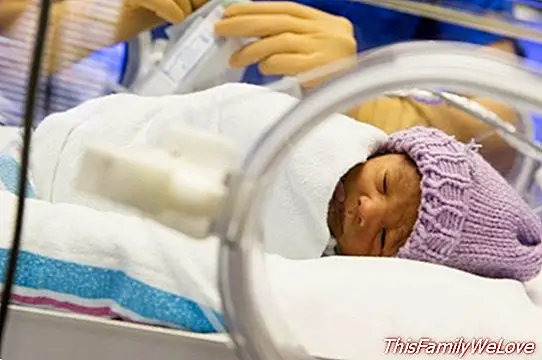The incubator and kangaroo method, vital for premature babies

The incubators are in the neonatology units where in addition to these we can find thermal and other normal cribs where the healthcare professional cares for newborns with problems. In this place, where you can breathe a calm and tender atmosphere, premature babies they are served and monitored twenty-four hours a day.
The incubator, essential for the survival of the premature baby
What is it that gives you the incubator to the premature baby? For fundamentally heat and humidity, necessary to protect the extremely fine skin that prematurely have the first days of life.
The IFncubadoras They are devices that isolate babies from the environment, preventing them from germs. They are not completely closed because they have several holes where a series of tubes are introduced that will allow us to provide the premature baby with oxygen, food and proper medication. Most incubators have six windows through which you can have contact with the baby.
The children are monitored, that is, a series of cables will transmit on a screen, the heart and respiratory rate, the electrocardiogram and the oxygen saturation of the child's blood. Other areas can also be monitored depending on the severity, such as blood pressure.
The "Kangaroo Method", the best care for your premature baby
The baby kangaroos are born embryonic, so they must live in the marsupial bag of their mother where, warm, safe and with many care, develop a few months until they can go out to the outside world. From this peculiar fact that takes place in nature, the Kangaroo Method takes its name.
Based on the skin-to-skin contact between the child and the mother or father, it is a practice that was discovered by chance and that significantly improves the evolution of hospitalized premature children. It is performed next to the incubator or baby's crib in the hospital, with the mother or father sitting in a comfortable chair holding the child against the chest. The child is covered with a blanket and the father or mother discovers the breast so that the skin-to-skin contact is total. It is important to perform at least one and a half hours a day so that the baby can reach the phase of deep sleep.
It promotes stimulation and the formation of an affective bond between the parents and the baby; It is very beneficial for the mother who breastfeeds her child, since it creates a very favorable environment for the child to breastfeed easily. Children "kangaroo" receive discharge before and cry less at 6 months of age, than those who were in contactless incubator. It can also be observed that they regulate temperature better, have a more controlled breathing and sleep more relaxed.
"Corrected age" in the first years for premature babies
The "corrected age" is the age that the premature child would have had if he had been born at the estimated date of delivery. It is used to evaluate the child during the first three years of life, comparing it with children born at term to assess the deviations in a more realistic way. That is, if a premature baby is born 28 weeks, will be subtracted about three months and when you have 18 months will be compared with children of 15 months to assess whether you have acquired the skills of this age.
Premature baby needs specialized care
The medical problems of a premature baby vary greatly depending on each child and their evolution during the first months. They tend to be more important the lower the gestational age or weeks of pregnancy. The immediate problems for large premature babies are usually nutritional, pulmonary, neurological, cardiological, ophthalmological, etc. Also in some cases they have to face learning disorders, dyslexia, hyperactivity or attention deficit. Often, parents have to go to numerous specialists and medical examinations and it is always convenient for children to see an early care specialist, where they will observe their development and apply specific stimulation, physiotherapy or speech therapy treatments.
20% of premature infants suffer from some type of vascular anomaly
According to Dr. Pablo Boixeda, a dermatologist at the Ramón y Cajal Hospital in Madrid, vascular anomalies affect 3% of newborns, but if we transfer it to premature children, the percentage goes up to 20%. The vascular pathology that has more incidence in children is the vascular angioma followed very closely by spider veins. Between 6th and 8th week the growth of these pathologies is faster.For this reason, it is recommended to visit the dermatologist at the first sign, since treating them when the children are older is more difficult, they become resistant, although the treatment is still very effective.
Cristina Murcia
Advice:Dr. Pablo Boixeda, Dermatologist at the Ramón y Cajal Hospital in Madrid




